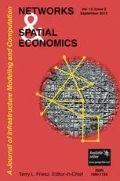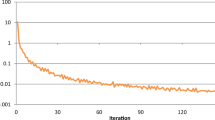Abstract
This study proposes an analytical capacity constrained dynamic traffic assignment (DTA) model along with an efficient path-based algorithm. The model can be applied to analyzing dynamic traffic demand management (TDM) strategies, but its specific feature is allowing for an evaluation of advanced traveler information systems (ATIS) within the strategic transportation planning framework. It is an extension of a former DTA model, where each link is given an infinite capacity and is assumed to be completely traversed inside any time interval it is reach by a path. Thereby, the length of time intervals should be very longer than the link travel times, and the link capacity constraints are overlooked. The paper rests on three key ideas to overcome these restrictions: (1) adding path-link fraction variables to the base model, allowing path flows to spread out over time intervals on long links; (2) uniformly dividing each link into smaller parts (segments), so that each part is more likely to be traversed inside a time interval; (3) imposing a dynamic penalty function on each link, thereby the capacity constraint can be included. The proposed DTA algorithm decomposes the augmented model in terms of origin-destination (OD) pairs and departure time intervals, and utilizes a dynamic column generation technique for generating active paths between the OD pairs. The optimal solution to a one-link network demonstrates that the model is able to approximate the dynamic flow propagation over a link with sensible accuracy. Besides, investigation of the results for a small test network reveals that the algorithm performs very well in computing temporal link flows and queuing delays. Finally, numerical experiments on a real life network indicate that the algorithm converges sufficiently fast and provides path information for each time interval. The network is further used to show the algorithm is capable of assessing a dynamic TDM strategy as well as an ATIS system.






Similar content being viewed by others
References
Ban XJ, Liu HX, Ferris MC, Ran B (2008) A link-node complementarity model and solution algorithm for dynamic user equilibria with exact flow propagations. Transp Res B Methodol 42(9):823–842
Beckmann M, McGuire CB, Winsten CB (1956) Studies in the economics of transportation. Published for the Cowles Commission for Research in Economics by Yale University Press, New Haven
Ben-Akiva M, Bierlaire M, Bottom J, Koutsopoulos H, Mishalani R (1997a) Development of a route guidance generation system for real-time application. In Proceedings of the IFAC Transportation Systems 97 Conference, Chania
Ben-Akiva ME, Koutsopoulos HN, Mishalani RG, Yang Q (1997b) Simulation laboratory for evaluating dynamic traffic management systems. J Transp Eng 123(4):283–289
Ben-Akiva ME, Gao S, Wei Z, Wen Y (2012) A dynamic traffic assignment model for highly congested urban networks. Transp Res C 24:62–82
Bliemer MC, Raadsen MP, Brederode LJ, Bell MG, Wismans LJ, Smith MJ (2017) Genetics of traffic assignment models for strategic transport planning. Transp Rev 37(1):56–78
Boyce DE, Lee DH, Janson BN, Berka S (1997) Dynamic route choice model of large-scale traffic network. J Transp Eng 123(4):276–282
Carey M (1987) Optimal time-varying flows on congested networks. Oper Res 35(1):58–69
Daganzo CF (1994) The cell transmission model: a dynamic representation of highway traffic consistent with the hydrodynamic theory. Transp Res B Methodol 28(4):269–287
Daganzo CF (1995) The cell transmission model, part II: network traffic. Transp Res B Methodol 29(2):79–93
Florian M, Mahut M, Tremblay N (2008) Application of a simulation-based dynamic traffic assignment model. Eur J Oper Res 189(3):1381–1392
Friesz TL, Bernstein D, Smith TE, Tobin RL, Wie BW (1993) A variational inequality formulation of the dynamic network user equilibrium problem. Oper Res 41(1):179–191
Friesz TL, Kim T, Kwon C, Rigdon MA (2011) Approximate network loading and dual-time-scale dynamic user equilibrium. Transp Res B Methodol 45(1):176–207
Friesz TL, Han K, Neto PA, Meimand A, Yao T (2013) Dynamic user equilibrium based on a hydrodynamic model. Transp Res B Methodol 47:102–126
Gentile G (2016) Solving a dynamic user equilibrium model based on splitting rates with gradient projection algorithms. Transp Res B Methodol 92:120–147
Golden B (1976) Technical note—shortest-path algorithms: a comparison. Oper Res 24(6):1164–1168
Han L, Ukkusuri S, Doan K (2011) Complementarity formulations for the cell transmission model based dynamic user equilibrium with departure time choice, elastic demand and user heterogeneity. Transp Res B Methodol 45(10):1749–1767
Han K, Friesz TL, Yao T (2013a) A partial differential equation formulation of Vickrey’s bottleneck model, part I: methodology and theoretical analysis. Transp Res B Methodol 49:55–74
Han K, Friesz TL, Yao T (2013b) A partial differential equation formulation of Vickrey’s bottleneck model, part II: numerical analysis and computation. Transp Res B Methodol 49:75–93
Han K, Friesz TL, Yao T (2013c) Existence of simultaneous route and departure choice dynamic user equilibrium. Transp Res B Methodol 53:17–30
Han K, Piccoli B, Szeto WY (2016) Continuous-time link-based kinematic wave model: formulation, solution existence, and well-posedness. Transportmetrica B: Transp Dyn 4(3):187–222
Han K, Eve G, Friesz TL (2019) Computing dynamic user equilibria on large-scale networks with software implementation. Netw Spat Econ 19(3):869–902
Hearn DW, Ribera J (1980) Bounded flow equilibrium problems by penalty methods. In: Proceedings of IEEE International Conference on Circuits and Computers, p 162–166
Janson BN (1991a) Dynamic traffic assignment for urban road networks. Transp Res B Methodol 25(2):143–161
Janson BN (1991b) Convergent algorithm for dynamic traffic assignment. Transp Res Rec (1328):69–80
Janson BN, Robles J (1995) Quasi-continuous dynamic traffic assignment model. Transp Res Rec (1493):199–206
Javani B, Babazadeh A (2017) Origin-destination-based truncated quadratic programming algorithm for traffic assignment problem. Transportation Letters 9(3):166–176
Javani B, Babazadeh A, Ceder A (2019) Path-based capacity-restrained dynamic traffic assignment algorithm. Transportmetrica B: Transp Dyn 7(1):741-764
Jayakrishnan R, Mahmassani HS, Hu TY (1994) An evaluation tool for advanced traffic information and management systems in urban networks. Transp Res C 2(3):129–147
Jin WL (2015) Point queue models: a unified approach. Transp Res B Methodol 77:1–16
Kachroo P, Shlayan N (2013) Dynamic traffic assignment: a survey of mathematical models and techniques. In: Advances in dynamic network modeling in complex transportation systems. Springer, New York, pp 1–25
Larsson T, Patriksson M (1995) An augmented Lagrangean dual algorithm for link capacity side constrained traffic assignment problems. Transp Res B Methodol 29(6):433–455
Lo HK, Szeto WY (2002a) A cell-based variational inequality formulation of the dynamic user optimal assignment problem. Transp Res B Methodol 36(5):421–443
Lo HK, Szeto WY (2002b) A cell-based dynamic traffic assignment model: formulation and properties. Math Comput Model 35(7):849–865
Mahut M, Florian M (2010) Traffic simulation with dynameq. In: Fundamentals of traffic simulation. Springer, New York, pp 323–361
Mahut M, Florian M, Tremblay N, Campbell M, Patman D, McDaniel Z (2004) Calibration and application of a simulation-based dynamic traffic assignment model. Transp Res Rec 1876:101–111
Merchant DK, Nemhauser GL (1978a) A model and an algorithm for the dynamic traffic assignment problems. Transp Sci 12(3):183–199
Merchant DK, Nemhauser GL (1978b) Optimality conditions for a dynamic traffic assignment model. Transp Sci 12(3):200–207
Mun JS (2007) Traffic performance models for dynamic traffic assignment: an assessment of existing models. Transp Rev 27(2):231–249
Nie YM (2011) A cell-based Merchant–Nemhauser model for the system optimum dynamic traffic assignment problem. Transp Res B Methodol 45(2):329–342
Nie X, Zhang HM (2005a) A comparative study of some macroscopic link models used in dynamic traffic assignment. Netw Spat Econ 5(1):89–115
Nie X, Zhang HM (2005b) Delay-function-based link models: their properties and computational issues. Transp Res B Methodol 39(8):729–751
Nie YM, Zhang HM (2010) Solving the dynamic user optimal assignment problem considering queue spillback. Netw Spat Econ 10(1):49–71
Nie Y, Zhang HM, Lee DH (2004) Models and algorithms for the traffic assignment problem with link capacity constraints. Transp Res B Methodol 38(4):285–312
Nie YM, Ma J, Zhang HM (2008) A polymorphic dynamic network loading model. Comput Aided Civ Inf Eng 23(2):86–103
Papageorgiou M, Ben-Akiva M, Bottom J, Bovy PH, Hoogendoorn SP, Hounsell NB, Kotsialos A, McDonald M (2007) ITS and traffic management. Handbooks in operations research and management science, 14, p 715–774
Peeta S, Mahmassani HS (1995) System optimal and user equilibrium time-dependent traffic assignment in congested networks. Ann Oper Res 60(1):81–113
Ran B, Boyce DE, LeBlanc LJ (1993) A new class of instantaneous dynamic user-optimal traffic assignment models. Oper Res 41(1):192–202
Shahbandi MG, Babazadeh A (2019) Analysis of a joint entry-and distance-based cordon pricing scheme: a dynamic modeling approach. J Mod Transp 27(1):25–38
Shahpar AH, Aashtiani HZ, Babazadeh A (2008) Dynamic penalty function method for the side constrained traffic assignment problem. Appl Math Comput 206(1):332–345
Sheffi Y (1985) Urban transportation networks. Prentice-Hall, Englewood Cliffs, N.J
Szeto WY (2013) Cell-based dynamic equilibrium models. In: Advances in dynamic network modeling in complex transportation systems. Springer, New York, pp 163–192
Szeto WY, Wong SC (2012) Dynamic traffic assignment: model classifications and recent advances in travel choice principles. Cent Eur J Eng 2(1):1–18
Ukkusuri SV, Han L, Doan K (2012) Dynamic user equilibrium with a path based cell transmission model for general traffic networks. Transp Res B Methodol 46(10):1657–1684
Wardrop J (1952) Road paper. Some theoretical aspects of road traffic research. ICE Proc: Eng Div 1(3):325–362
Zhang HM, Nie Y, Qian Z (2013) Modelling network flow with and without link interactions: the cases of point queue, spatial queue and cell transmission model. Transportmetrica B: Transp Dyn 1(1):33–51
Ziliaskopoulos AK (2000) A linear programming model for the single destination system optimum dynamic traffic assignment problem. Transp Sci 34(1):37–49
Ziliaskopoulos AK, Waller ST, Li Y, Byram M (2004) Large-scale dynamic traffic assignment: implementation issues and computational analysis. J Transp Eng 130(5):585–593
Acknowledgements
The authors are grateful to the three anonymous reviewers for their thoughtful comments and constructive suggestions.
Author information
Authors and Affiliations
Corresponding author
Additional information
Publisher’s Note
Springer Nature remains neutral with regard to jurisdictional claims in published maps and institutional affiliations.
Rights and permissions
About this article
Cite this article
Javani, B., Babazadeh, A. Path-Based Dynamic User Equilibrium Model with Applications to Strategic Transportation Planning. Netw Spat Econ 20, 329–366 (2020). https://doi.org/10.1007/s11067-019-09479-0
Published:
Issue Date:
DOI: https://doi.org/10.1007/s11067-019-09479-0




